This is a Zeiss-Ikon Contaflex Super, a 35mm Single Lens Reflex leaf shutter camera made by Zeiss-Ikon AG in Stuttgart, West Germany between the years 1959 and 1962. It was part of the long lived Contaflex series that saw many variations between the original Contaflex I in 1953 all the way to the Contaflex S from about 1970. The Super, as it’s name implies was a rather high spec version of the camera, featuring a coupled selenium exposure meter with match needle readout in the viewfinder, and a 4-element 50mm Tessar lens with interchangeable front elements. With the use of Pro-Tessar bayonet mount lenses, the Contaflex had available wide angle and telephoto lenses.
Film Type: 135 (35mm)
Lens: 50mm f/2.8 Carl Zeiss Tessar coated 4-elements
Lens Mount: Contaflex Bayonet (front element only)
Focus: 2.5 feet to Infinity
Viewfinder: Fixed SLR Pentaprism
Shutter: Synchro-Compur Leaf
Speeds: B, 1 – 1/500 seconds
Exposure Meter: Coupled Selenium Cell w/ viewfinder and top plate match needle
Battery: None
Flash Mount: Coldshoe and M and X Flash Sync
Weight: 850 grams
Manual: http://www.cameramanuals.org/zeiss_ikon/zeiss_ikon_contaflex_super-02.pdf
How these ratings work |
The Zeiss-Ikon Contaflex Super was a later variant of the original leaf shutter Contaflex with interchangeable front lens elements, a coupled selenium exposure meter with viewfinder readout, and a redesigned body. Although these cameras have a higher than usual rate of failure over the years due to the complexity of the shutter, when found in working condition are fantastic cameras. The pentaprism viewfinder is brighter than most SLRs of the day, and the 50mm Tessar lens is as good as any out there. If you are lucky enough to find one of the auxiliary Pro-Tessar lenses, the camera is surprisingly capable in a variety of situations. I thoroughly enjoyed my time with this camera and although it’s not my favorite leaf shutter SLR, it’s a damn good camera. | ||||||
| Images | Handling | Features | Viewfinder | Feel & Beauty | History | Age | |
| 2 | 2 | 1 | 2 | 2 | 1 | 20% | |
| Bonus | none | ||||||
| Final Score | 12.0 | ||||||
History
The Carl Zeiss Foundation has a long and rich history that dates back to the 1800s which I’ve covered in other reviews for cameras like the Zeiss-Ikon Nettar 515 and Zeiss-Ikon Icarette 500/15. If you’d like to know more, I suggest reading the history sections in those articles.
 For this article, I’ll start at the end of World War II when Zeiss-Ikon Dresden was split into separate Zeiss-Ikon companies, one based in Stuttgart, West Germany, and the other in Dresden, East Germany. An agreement between the Allied controlled West German government and Soviet controlled East German government allowed both companies to use the Zeiss-Ikon name, but trademark disputes were common throughout the entire brand. For a short while after the war, the West German company was named Zeiss-Opton Optische Werke Oberkochen GmbH, but soon changed back to Zeiss-Ikon after relocating to Stuttgart.
For this article, I’ll start at the end of World War II when Zeiss-Ikon Dresden was split into separate Zeiss-Ikon companies, one based in Stuttgart, West Germany, and the other in Dresden, East Germany. An agreement between the Allied controlled West German government and Soviet controlled East German government allowed both companies to use the Zeiss-Ikon name, but trademark disputes were common throughout the entire brand. For a short while after the war, the West German company was named Zeiss-Opton Optische Werke Oberkochen GmbH, but soon changed back to Zeiss-Ikon after relocating to Stuttgart.
In the late 1940s, Germany was still heavily battered from the war, and the rest of the world did not see Germany as a respected economic power, but any reservations the rest of the world had towards German produced items seemingly did not apply to German cameras and other optical goods. German cameras were highly prized souvenirs by Allied soldiers during the war, and afterwards the demand for quality built German cameras was very high.

The Contessa-Nettel factory in Stuttgart, which Zeiss acquired in it’s 1926 merger, was largely spared damage from the war and was the only one of Zeiss’s major facilities that would not fall under control from the Soviet government, so it was chosen as the logical site for a West German Zeiss resurgence. The Contessa factory was the smallest of the 4 major Zeiss-Ikon factories in pre-war Germany and had the least number of employees.
In the first few years after the war, 100% of the production from the Stuttgart factory was handed over to the American military and were sold via the military’s PX retail stores. In my research for this article, I came across an interesting story where at first, American officers would pay Zeiss for their cameras using cash, but later would give them a blank check which would be filled in for whatever amount the company wanted to charge. Due to the small size of the Stuttgart factory, Zeiss struggled to keep up with demand. It wasn’t until around 1951 when a couple of new buildings were built next to the original factory to increase production.
Prior to the war, most of Zeiss-Ikon’s design work was done at the Dresden factory and it was there where the majority of new cameras were created. The Stuttgart factory produced most of Zeiss’s compact roll film cameras like the Ikonta and Nettar series, so those were the first models to resume production.
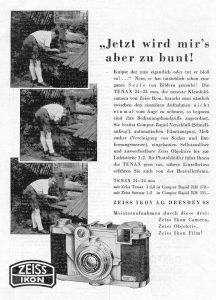
Shortly after resuming production of these models, Zeiss-Ikon sought to revive the reputation of the Zeiss brand by releasing a series of compact new 35mm cameras designed by famed designer Hubert Nerwin. Nerwin had been a Zeiss employee since before the war, and is credited for some of the brand’s most successful designs, including the Contax II and III rangefinder, Contaflex TLR, the Super Nettel, and Tenax compact camera.
During the war, Nerwin had been focused on the German war effort and adapted some existing Zeiss bodies in use for war photography. It was clear before the war that compact 35mm cameras like the Leica and Contax would continue to rise in popularity and would be the future of the company so during his free time, Nerwin worked on several new compact 35mm prototypes. Sadly, all of his war-time prototypes were destroyed in the bombing of Dresden, but it would be these ideas that he had in his head which he would later develop in Stuttgart.
Shortly before the end of the war when it was obvious Germany was losing, Nerwin fled Germany and took his family back to Austria where he was originally from, and rode out the rest of the war in hiding. After the war, he made his way to Stuttgart where he hoped to re-join Zeiss-Ikon and continue his work there.
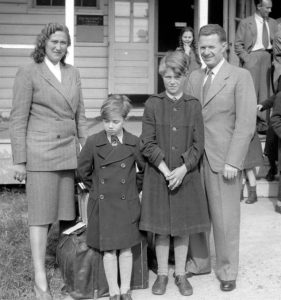
When Nerwin arrived at the Contessa factory, he was initially turned away by the French occupation that was short lived in that era, but once the Americans moved in, he was welcomed and put into a position where he could help rebuild the reputation of Zeiss-Ikon. It was important for Zeiss-Ikon to put into production new 35mm models, but the company’s Contax rangefinders were too complex for the small Stuttgart factory to handle so they had to come up with something else.
Hubert Nerwin would only work in Stuttgart for 2 years, but in that time he put into production three different compact 35mm cameras that were based off his prototypes that he had developed in Dresden during the war. He would leave Germany in 1947 for the United States where he and his family would eventually relocate in Rochester, NY where he would eventually work for Kodak and Graflex.
One of those three new cameras was the Contaflex SLR. The name “Contaflex” was borrowed from a previous 35mm twin lens reflex camera produced by Zeiss-Ikon prior to the war, but otherwise shared no similarities with the new 35mm SLR.
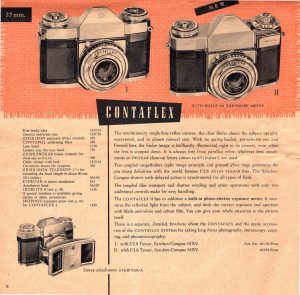
Feeling the pressures of both the up and coming Japanese camera industry and the rise of the 35mm SLR, Zeiss-Ikon, like most German companies wanted to build off their success with leaf shutter rangefinders and folding cameras. The idea of a “central shutter” camera had some merit. For one, it was a shutter design that these companies already had a lot of experience with, so the R&D phases of building new focal plane cameras like the Japanese could be minimized. Also, central shutters were better for flash photography as the shutter could be flash synced at all speeds, compared to the relatively low 1/50 and below sync speeds of focal plane shutters.
The new camera was sold in both meter-less and metered versions, called the Contaflex I and II. It was an ideal first SLR for Zeiss-Ikon as it used a design that was mostly finished prior to it’s release, it used a Compur shutter that was known to be reliable, and without an interchangeable lens mount, was pretty simple to design. The formula worked well by building upon the excellent reputation of Zeiss lenses. According to this February 1956 price list, the Contaflex I had a retail price of $169 with the metered Contaflex II at $199.99. When adjusted for inflation, these prices compare to $1589 and $1871 which certainly wasn’t cheap, but was considerably less than competing pro-level SLRs like the KW Praktina and the Ihagee Exakta.
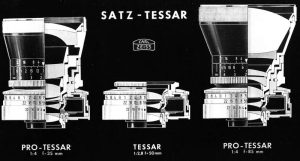
The Contaflex sold well, and in 1956 two updated models called the Contaflex III and IV made their debut adding a helical focus and an interchangeable front lens grouping. This design was not a true interchangeable lens mount like other SLRs had, but rather the front elements of the 50mm Tessar could be swapped, changing the focal length to either a wide angle or mild telephoto focal length.
Edit 12/21/18: After publishing this article, an eagle eyed reader pointed out that I missed several accessory lenses that were available in the Contaflex line such as a 115mm f/4 Pro-Tessar and a push on (doesn’t use the bayonet) Monocular 8x30B lens. While yes, these lenses did exist, they are not mentioned in the Contaflex Super’s manual as available lenses upon this models release. So while I could have noted every possible lens that at one point in time was available for the entire Contaflex line, I chose not to get that complex and stuck with the lenses specifically mentioned in the user manual for the model being reviewed here.
The design of the Contaflex largely remained the same until 1958 when a new model called the Contaflex Rapid made it’s debut. It had a larger and more modern body while still sharing the same interchangeable front lens elements from the III and IV, but the biggest change was in 1959 with the release of the Contaflex Super with it’s coupled selenium light meter. For the first time, the Contaflex could be seen as a less expensive competitor to more expensive professional SLRs with it’s accessory lenses, stereo attachments, coupled meter, and bright viewfinder. Selling in 1959 for $199.99 which compares to about $1717 today, it was considerably cheaper than Japanese focal plane SLRs like the Nikon F at $329.50 or the Minolta SR-2 at $249.50.
The Contaflex series sold well enough to continue to be updated throughout the 1960s, but it’s place in the market was a bit confusing. It was too expensive to be considered an entry level camera, yet it lacked the flexibility of professional SLRs. Other German camera makers like Voigtländer (who by the early 1960s Zeiss-Ikon had a controlling interest in), AGFA, and Kodak AG would continue making central shutter SLRs, but it was a design that would eventually fade away by the end of the next decade.
Today, the Contaflex is a well respected, but often overlooked camera by collectors. While the name Zeiss-Ikon and Tessar are generally considered to be two of the most popular names in camera design, the relative unreliability of the leaf shutter design reduce their popularity among collectors who also shoot their cameras. The value of a Contaflex is also negatively impacted by the vast number of them still available out there. As I write this, a quick search for the name “Contaflex” on eBay brings up more than 250 results for sale making them quite common. Still, despite the poor reputation of leaf shutter SLRs, and the somewhat basic feature set of most models, the Contaflex is worth considering. If you can find a confirmed working one with a clean lens, you could do a lot worse!
Repairs
If there’s one rule that every new camera collector needs to know, is “don’t mess with leaf shutter SLRs”. Leaf shutters are complex enough as they were on folding cameras and rangefinders, but when added to a Single Lens Reflex camera, a whole other level of complexity was needed. It also didn’t help that most companies who built leaf shutter SLRs were German, and there’s that old saying “if something could be built to use six parts, the Germans would use twelve”.
With that in mind, there is one minor “repair” that can somewhat easily be done on the Contaflex which is cleaning the focusing screen. On most focal plane SLRs, if some debris has gotten on the reflex mirror or the underside of the focus screen, you simply remove the lens and gently take a Q-tip and wipe it off. The design of the Contaflex makes this impossible as you can’t ever get directly into the mirror box because of an inner lens element that isn’t easily removable.
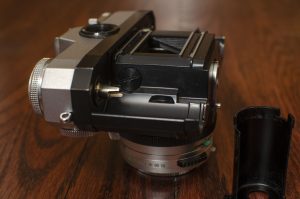
Thankfully, the designers at Zeiss-Ikon (whether intentional or not), made a little access door from within the film compartment to get a Q-tip or even the nozzle of canned air in there to clean off the screen and mirror.
In order to access the hole, you need to pull out a little shield on the supply side of the film compartment. This shield is not screwed in, and should just pull out with a tug. Once it is out, you should have access to the slotted door, which simply unscrews with a large screwdriver. In the image to the right, the shield is on the floor next to the camera.
With the door open, access to the viewing screen and mirror is still tight, but should give you enough room to clean out most debris. Although I wouldn’t recommend it, I’ve read of people using compressed air to blow debris out. While this might actually work, it just seems like a bad idea to potentially push debris further into the camera.
My Thoughts
Some cameras come to me with a level of excitement to which I can’t wait to load them up with a fresh roll of film and see what I can get out of them. Others take much longer. This Contaflex Super belongs in that second group.
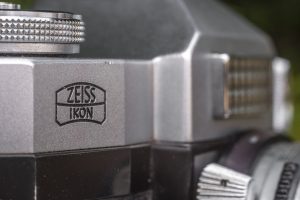
I’ve sat on this camera for well over a year before taking it out for it’s inaugural roll and getting this review done. The reason for the delay really isn’t the fault of the camera at all but more to how it was stored. For starters, it came in it’s original ever-ready case and stunk to high hell when I opened it up. This was probably the stinkiest camera I’ve ever come across with a cornucopia of offensive olfactory delights like mold, smoke, and ‘who-the-hell-knows-what-else”. It was bad. I almost didn’t even keep the camera, but one side effect of having your own camera review site is that there is always something else to play with, so that allowed this Contaflex to sit in my basement for months, allowing it to air out from it’s camera bag hell that it likely sat in for decades.
After coming back to the camera nearly a year later, I was pleased to see that most of the odor was gone, apart from a close-up shove of my nose into the film compartment. I then began to address the second problem, which was the stuck shutter and filthy viewfinder. In the section above I talk about how to remove a little port to gain access to the mirror box for cleaning which was simple enough. Knowing full well that leaf shutter SLRs are not to be messed with, I made one valiant attempt to soak the entire shutter with naphtha oil in an attempt to free it. Amazingly, it worked, and even after letting the camera air dry for a week, it sprung to life and seemed to be working okay. Not wanting to tempt fate much longer, I loaded up a roll of film and took it out.
The Contaflex, like most German cameras of the day has a decent amount of heft to it and feels well made. The chrome plating was still shiny (after a wipe down) and the body covering was entirely in tact. The camera’s weight of 850 grams with the base Tessar 2.8 lens isn’t exactly light weight, but the compactness of the Contaflex helps disguise the weight. There are strap lugs on the sides which allow a neck strap to be used, which I recommend for long shooting sessions. I found the handling of the camera to be superb, and with only one exception, all the necessary controls were exactly where you’d expect to find them.

The top plate is rather ordinary for a German SLR. On the left is the rewind knob with a flip out handle and a film reminder disc. There are numbers indicating ASA film speeds from 10 – 1300 along with another ring with a limited number of film types. Next to the rewind knob is the top match needle readout. This readout is redundant as it is also visible from within the viewfinder. On top of the pentaprism is an accessory shoe and to it’s right is the film advance lever with exposure counter on top. The exposure counter is manually resetting, and counts backwards, showing how many remaining exposures are left on the roll. Also viewable from the top of the camera are the shutter speed dial, aperture ring, and focused distance.
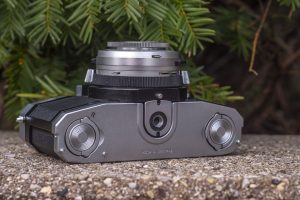
On the bottom of the camera are two ‘Leica-style’ door locks that when are each rotated 180 degrees release the entire back of the camera. These allow for metal reloadable cassettes to be used on both the supply and take up side of the camera. In the middle is the 1/4″ tripod socket. The socket itself is built directly in the main body of the camera, rather than the door, for strength. The bottom of the camera also features 3 little feet that keep the camera elevated off a flat surface when set down. This is a nice little touch that prevents the bottom from getting scratched up.
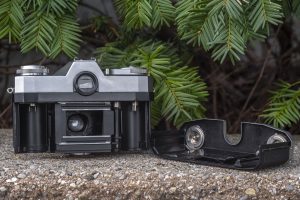
With the back of the camera off, we see a rather ordinary looking film compartment. A new cassette installs on the left, and on the right is a removable take up spool. While it’s best to not lose the original take up spool for the camera, but if that happens you can simply sub in the inner spool from an ordinary 35mm cassette or even a whole cassette for cassette to cassette transport. The Contaflex has very deep channels around the back and requires no foam or yarn to keep out light. The bottom of the inside of the door is lined with a black felt, but otherwise had no other light seals.
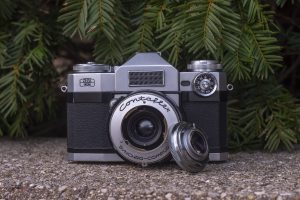
Starting with the Contaflex III, the front element of the Tessar lens is removable and can be swapped with a couple of auxiliary wide angle or telephoto Pro-Tessar lenses. Although not a true interchangeable lens system like many SLRs, this allowed increased flexibility for the Contaflex.
Removing the lens requires a small lever with a red dot located at the 6 o’clock position of the shutter to be pushed in while simultaneously rotating the outer lens element counterclockwise. Installing a new lens requires a red dot on the back of the bayonet to be lined up and rotated clockwise until it clicks. On my example, the process for removing the lens element was quite stiff. My guess is that very few people ever used any of the auxiliary lenses, causing them to be a little more difficult to remove.
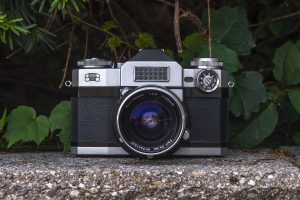
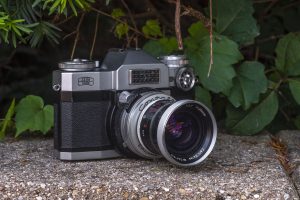
I was fortunate to come across the Pro-Tessar 35mm f/3.2 wide angle lens for the Contaflex and used it during the inaugural roll through this camera. A word of caution is that there was also an f/4 wide angle Pro-Tessar that seems to have been made with an inferior lens glue that over time can badly separate. In my research for this article, nearly every f/4 wide angle Pro-Tessar exhibited mild to severe separation within the front elements. It shows up as a rainbow like distortion in the glass, almost like an oil slick. I have no idea how much that might effect the images, but I never found out. Instead, I got this f/3.2 version which seems to be more immune to separation, so it’s the one I would recommend if you were looking to pick one up.
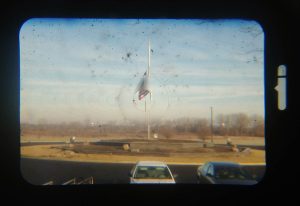
The viewfinder on the Contaflex, like many German leaf shutter cameras is incredibly bright. Like the Voigtländer Bessamatic Deluxe which I recently reviewed, the reason for the abnormally bright image is that only the central circle of the viewing screen can be used for focus. The rest of the glass is a clear Fresnel pattern brilliant finder that simply shows the composed image with no indication of the focused image. In the center is a large and bright split image rangefinder, and around it a ground glass focusing aide. Both aides are large and very easy to use and the lack of focusing ability on the rest of the viewing screen is much less of an issue than it probably seems. In the image to the left, I intentionally set the lens to minimum focus and pointed it at the flagpole so you can see what it looks like. Notice everything outside of the ground glass circle still looks in focus, even though it’s not.
Also visible within the viewfinder is the match needle readout from the top plate of the camera. This readout gets it’s illumination from a small window on the front of the camera next to the aperture control wheel. Finally, the reflex mirror inside of the Contaflex is not of the ‘instant-return’ type, which means the viewfinder is blacked out after each press of the shutter release. To see through the viewfinder, you must wind the film advance lever to lower the mirror.
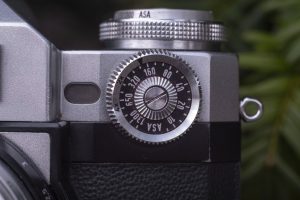
The aperture control wheel is the round knurled wheel located in the upper right corner when viewing the camera straight on. This wheel is the most distinctive feature of the Contaflex Super and does not appear on any other model. It serves two purposes, the first, is to set the calibration of the film loaded in the camera for the meter. Like the film reminder dial on the rewind knob, the shown ASA speeds are 10 – 1300. Common modern speeds like 100, 200, and 400 are all indicated by hash marks. To set the film speed, press down on the center of the wheel towards the body while simultaneously rotating it so that your speed lines up with the black triangle. You’ll notice a ‘2x’ and ‘4x’ indicator which is a sort of exposure compensation setting, most likely when using filters on the camera. To use it, rotate your loaded film speed to either of the 2x or 4x setting instead of the black triangle.
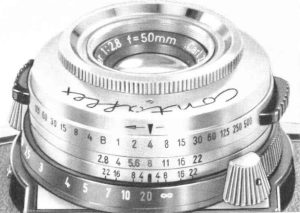
The other function of this wheel is less obvious, controlling the aperture. While the Tessar’s available apertures of 2.8 through 22 are indicated around the lens, you can’t actually change it on the lens. You need to turn this dial. This was not obvious to me when I first got the camera, and grew frustrated until I looked up the manual to figure out how to do it.
The reason for this control is that the Contaflex, like many cameras from the mid to late 1950s, employed a kind of Light Value Scale (LVS) system which couples the selected shutter speed and f/stop to a fixed setting. The reason I say “kind of” is that there aren’t any LVS numbers visible anywhere on the camera. I found this to be incredibly bizarre and a bit frustrating. Thankfully, changing the aperture using the aperture control wheel is very easy, but it is something that you will most likely need to re-familiarize yourself with each time you pick one of these cameras up.
With the sole exception of the “not-LVS” system and “not-obvious” aperture control, using the Contaflex was quite pleasant. It’s always a good idea to expect some level of quirkiness when using a mid-century German camera, and the Zeiss-Ikon Contaflex Super is no exception. Yet, unlike some of their country mates, I think that Hubert Nerwin mostly got it right with this one. The Contaflex is a handsome, and easy to use camera that came with an excellent base lens that makes outstanding images. I don’t know that if I was shopping for a camera in 1959, I would have plunked down the equivalent of $1700 today, but for the low prices they go for today, for me it was a no brainer!
My Results
With the Contaflex sufficiently de-stink-ified, the shutter working, and the viewfinder reasonably clean, I loaded in a roll of fresh Fuji 200 and took it with me on my every day adventures for a week during late summer 2018. I kept the Pro-Tessar 35mm f/3.2 lens on the camera most of the time but did shoot a few with the base 50mm f/2.8. The disorganized person that I am, never bothered to track which images were shot with either lens, so, sorry about that!
As you might expect from any camera with a Tessar lens, the results came out great. Sharpness was excellent all around, colors rendered accurately on the fresh Fuji film, and most optical aberrations were either non existent or kept to a minimum. People pay crazy money for Yashica T-series plastic point and shoots to get this same exact lens, yet Contaflexes regularly go unsold for peanuts!
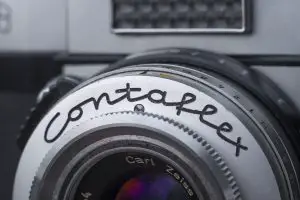
The addition of the wide angle Pro-Tessar increased the cool factor of this camera. If there’s one thing that bores me about fixed lens cameras is the limited ~50mm focal lengths found on most of them. My natural shooting style is a little wider, somewhere in the range of 40mm, so with this 35mm lens, I was in heaven. The meter was accurate, and although I didn’t love the arrangement of how apertures were selected, on the scale of German weirdness, with a Kodak Retina Reflex being the worst offender, the Contaflex wasn’t bad at all. I will say though, that when you mount one of the auxiliary lenses to the camera, you’ll never mistake it for a normal interchangeable lens SLR, it very clearly looks like one lens is grafted onto the front of another.
What I liked the most about using the Contaflex is that most Tessars in my collection are attached to rangefinders and don’t offer through the lens composition like an SLR does. Adding to the thrill was the wide angle lens and I had myself quite a capable little shooter. Sure, the Contaflex can’t really be described as a “full system camera” as it only gave you one of three different focal lengths to choose from, but that’s okay!
Do I think the Contaflex Super lives up to it’s “Super” name? Yeah, I’d say it does. It’s not my favorite leaf shutter camera, but it’s still a very good example. These things are incredibly common in the used market, but sadly, so are those with problems. If you can find one that is in confirmed working condition, or like to play “naphtha roulette” like me, then I absolutely recommend giving one of these cameras a try!
Related Posts You Might Enjoy
External Links
https://en.wikipedia.org/wiki/Contaflex_SLR
http://www.alexluyckx.com/blog/index.php/2017/02/22/ccr-review-57-zeiss-ikon-contaflex-super-old/
https://www.photo.net/discuss/threads/the-zeiss-ikon-contaflex-super.422363/
https://retinarescue.com/contaflexsuper.html
http://www.collection-appareils.fr/x/html/page_standard.php?id_appareil=12074 (in French)
http://www.camarassinfronteras.com/contaflex/contaflex.html (in Spanish)

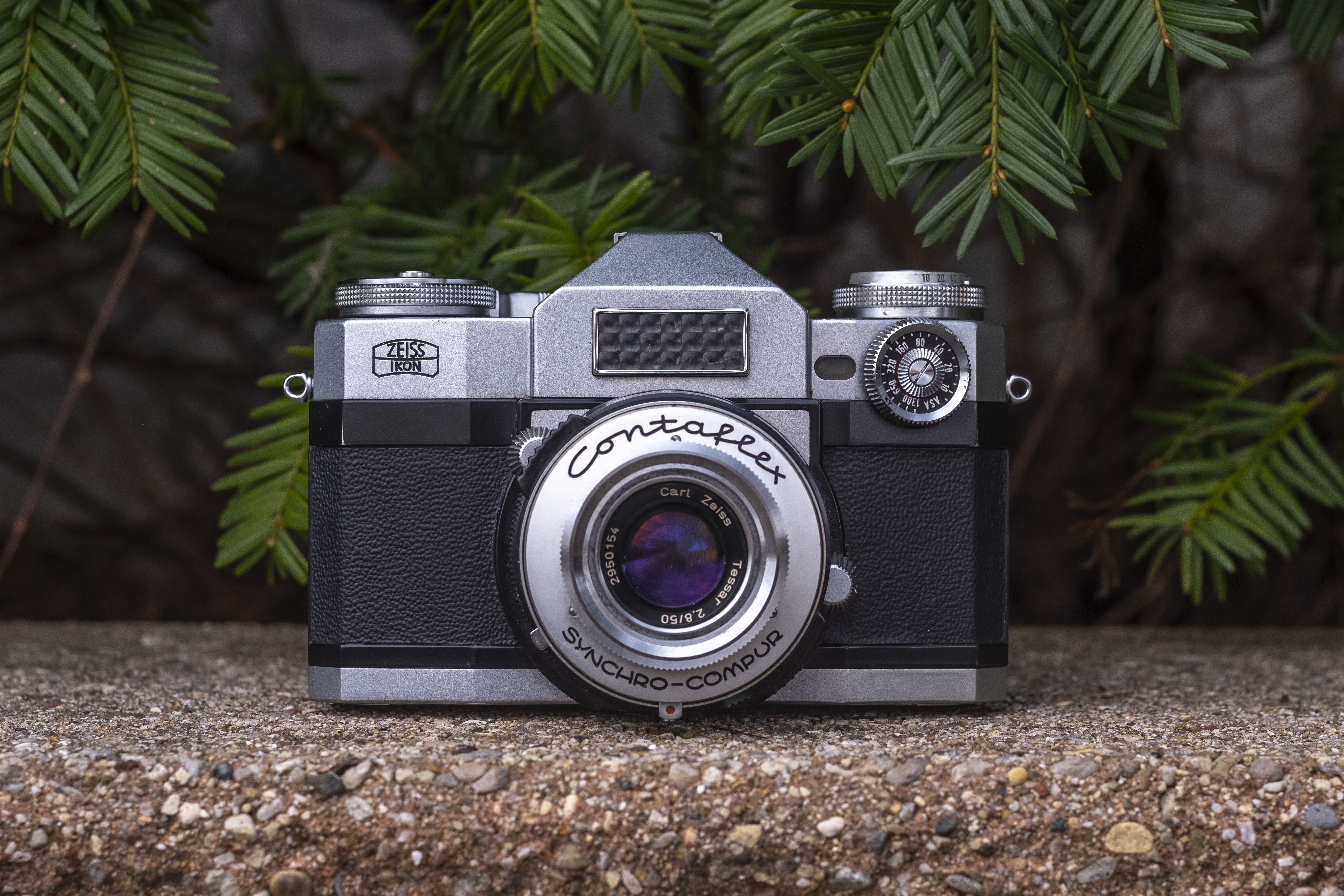
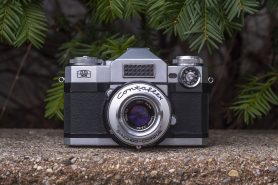
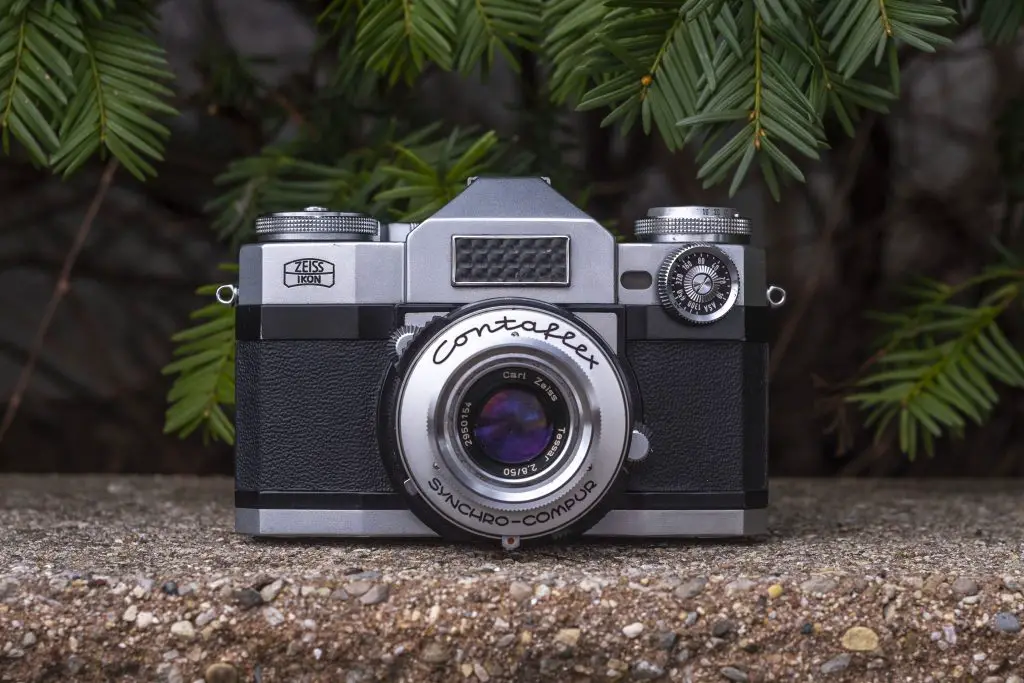














just a question. I bought a 35mm Pro-Tessar 3.2, and at the back there is a skinny ring that rotates freely without seeming to do anything. It has distance markings, from 0.7m to infinity. Any idea what it is for?
Nigel, it’s been almost a year since I shot mine, I’ll have to dig it out of the cabinet and play with it. My instinct is to say, that ring shouldn’t rotate, but I honestly can’t remember! 🙂
The ring is intended to rotate and is used to set the DoF scale in the Pro-Tessar lenses. Focus the camera as normal, note the focused distance on the focusing ring on the shutter and then set this distance to the reference point on the Pro-Tessar. Now read off the DoF on the Pro-Tessar.
In the 1970’s, I was looking at leaf shutter, roll film SLRs to move up from the Minolta Autocord or the Rolleicord V. The Kowa Six was on the low end of the pool, with the Mamiya RB67 or Hasselblad 500C at the top end. The Mamiya M645 arrived on the market, but the electronic flash synchronization speed was no better than a 1960’s 35mm SLR. Then the Zenza Bronica ETR series arrived, and that was more affordable than the always-out-of-reach Hasselblad.
Could I get used to a “wind the shutter to lower the reflex mirror and open the taking lens” 120 SLR? I took the cheapest route available by looking at interchangeable lens leaf shutter 35mm SLR cameras. Eventually, I settled on a Zeiss Ikon Contaflex IV from eBay, since it was compact and had the eqiuvalent of interchangeable lenses. Since this was a “slow down to make serious images” type of camera, compared to the Nikkormat FTN, it took time to get used to it.
I had looked at the rapid wind lever versions, but this “leaf shutter 35mm SLR Contax” was fine with me. For a number of years I used the Contaflex with black-and-white, color negative, and even Kodachrome with great results. Shopping at eBay yielded a near-complete lens component set, from 35mm f/3.2 to 50mm f/2.8 to 115mm f/4 Zeiss glass. Did the lack of wider-than-35mm or longer-than-115mm lenses bother me? Not much, since the Nikkormat filled in the 24mm to 300mm lens range.
Eventually, the experiment came to an end, I sold the Contaflex IV outfit, and bought a Bronica ETR-C and a lens or three. The Contaflex IV never failed to work, and this tiny 35mm SLR attracted more attention than the “pedestrian Nikkormat FTN.”
Mike, how did you actually “flood” the lens with napha to get it working? Take it off? Turn it upside down in a container with the camera still attached?
Hi Bob, I just took the front lens grouping off and doused the shutter with naphtha. I buy it by the gallon from the hardware store, so I can afford to be generous with it. I hold it at a 45 degree angle above my utility sink and let it run out as I’m squirting it. After a good douse, I fire it a dozen or so times, then let it air dry over night and repeat the next night until it stays working. I did that about a year ago, and so far so good!
Mr Eckman, I just got one of these with a problem(s). It appears near mint but the shutter is jammed. So the mirror is not moving and it won’t cock or release. The shutter is open at about f4(?) My research gave results that matched your comments. Great when they work but not repairable in 2020. So a shelf queen or parts or I might explore the mysteries myself. I also got a Vito BL from the same estate, it is getting film today. The info I have learned is I am the second owner and he/she did have them serviced at least once.Thank you for the article, this Zeiss Ikon may never take another photo but I don’t want to give up on it. Jerry
Jerrold, you may be interested to read this. http://www.zeisscamera.com/services_slr.shtml
I have four of the later models up to the S, all work mechanically but with one the cds meter is duff and on the S the auto exposure aperture setting doesn’t work. As Mr.Scherer says, these cameras can appear cosmetically excellent because they were so well made, but this can still hide hidden issues because of their complexity. The innards of these cameras is very complicated and I wish you luck if you try a DIY repair.
Terry, thanks for the reply. I have seen this, good info. Jerry
Sounds like the old sticky leaf shutter SLR problem that plagues many of these cameras. As Terry mentioned in his reply, even cameras that appear cosmetically perfect, likely won’t work because they’ve hardly ever been used or exercised over their lifetimes. While this is certainly no guarantee of functionality, I’ve found that more times than not, cameras that show heavy signs of use over the years are more likely to still work since they’ve been used with such regularity.
That said, sometimes there’s nothing you can do to guarantee a perfectly working camera, which exposes a kind of “lie” that vintage camera review sites like mine often tell. When I review a camera, I try to review it with the assumption that the camera is fully working. Sometimes it requires me to go through 2-3 or even more of a model to find one that works, and even when it does work, sometimes it’s not fully working. I often borrow cameras from collectors who might have previously had theirs serviced (How do you think I found a working Kodak Ektra?!)
That said, sites like mine can sometimes mislead people into thinking that if I got a good working copy that any out there will be in equally good working order, but sadly, that’s not true. My hope though is that by doing the best job I can to tell you the strengths and weaknesses of a camera, you can make a better decision if it’s worth it to keep seeking out new examples in the quest to find a good working one, or even pay the price to have someone service them.
Good luck in whatever you do. The Contaflex is certainly a nice camera and I enjoyed using mine (I have a couple), but there are certainly many others out there that are just as fun to use and might have a better chance at working.
Mike, thanks for the info and your time. I absolutely realize that these cameras are like old cars, meant to be used(not abused). And I also realize that it might be possible to find a great working example but not always. So my example looks good, I plan to give it a ‘bath’ in solvent to see if things free-up. I tried some warmth this morning. Maybe I’ll alternate warmth then a bath (after it has cooled some). If I get success, my neighbor gave me a brick of tmax 400. And she has more in the frig. I do appreciate your thoughts and advice, so again THANKS! Jerry
Jerry, I hope you can bring the camera back to life as I’m sure you will appreciate it and have fun using it. Did you know that Zeiss made interchangeable film backs for it? Quite a rare feature on any 35mm camera.
My only experience with this type mechanism is with a Kodak Retina Reflex C. I did have a copy of the repair manual but even so it is not something to take on lightly. Getting the cams and levers to sync so that the correct sequence is followed when winding on is a bit of a game. Wear in any of these means it will be nigh on impossible to ensure correct functionality and as Mr. Scherer pointed out the parts will need to be replaced.
Another potential problem may be that the parts could have been damaged at the first signs of trouble if an owner attempted to force the wind level. This is not to be recommended for any camera but is especially important for leaf shutter slr’s.
I have been lucky enough with my acquisitions so far and which, in addition to the four Contaflexes, comprises of a Bessamatic mk. II, Retina Reflex III, Agfa Coloflex, Topcon Wink Mirror S and a basic Kowa. There is just something about the sound a leaf shutter slr makes when it is fired.
Good luck Jerrold! In terms of the solvent bath, I highly recommend using naphtha oil. You should be able to buy it by the half gallon at most home improvement stores in the paint section. My local Home Depot sells a half gallon can for $7. You can use lighter fluid like Zippo or Ronsonol too, but those are just more expensive.
My last tip is when flushing it, use a LOT. Don’t be stingy. Get the front element off, and hold the camera at about a 45 degree angle over a utility sink and flush it and let the fluid keep running out. Cycle the camera a bunch of times when it’s wet to work it in. Let it air dry over night and check it. It’ll likely still be sticky the next day. Repeat the process over and over. It has sometimes taken me as many as 6 cycles of this before a camera I was flushing stayed working after it dried.
Finally, once you get it working OK, check any glass elements that are in the camera (I think the Contaflex has a glass element behind the shutter) and clean off any residue that settled on the glass from the flushing process with a Q-tip and some lens cleaner.
Very very good article. Thank you so much for researching this camera.
Great blog post! My neighbor recently gave me a Contaflex II that belonged to his Uncle back in the day, who was a pro photographer, as am I. I honestly was going to add it to the shelf with the rest of my collection of old cameras, but I got a bug up my butt and started playing around with it. It’s in pretty good condition. Shot a couple rolls which I will have developed asap. Good to see the what the lens quality is from your article. Not the sharpest, but there’s a nice vintage look to the images. Hoping to use it a lot more, for fun, and who knows, maybe even for a pro shoot or two!
Great review, Mike. I just today received a beautiful copy of this camera with case. Everything seems to work. The only exception is that the take-up spool was missing, but I took the spool from an ancient roll of Kodachrome and it fits perfectly (I just have to tape the film on to the spool when loading). I notice that the ASA dial has a marking for 320, then two hash marks, then 650. Which hash mark represents ASA 400 (which I use all the time)? Is it the one closer to the 320, or the one closer to 650? Thanks!
Good call on the empty spool as that’s what I recommend for most cameras. On occasion, when using an inner core spool in lieu of the real thing, film alignment can be off by an ever so small amount, but it’s usually not a big deal. As for the ASA film speed, I took a look at the camera’s manual and it does not specify the in between numbers, but since 400 is closer to 320 than 650, it’s a pretty safe bet that the hash mark closer to 320 is the right one. To be honest, the meter probably isn’t that accurate anyway, so as long as you pick one of the two, you’ll be in the ballpark. Good luck!
Many thanks, Mike. Now I’m in the market for the Bessamatic Deluxe, based on your rave review. You are definitely a danger to my wallet!
just got one of these in working order as part of an auction lots with a later model contaflex and a contarex bullseye body. all 3 cameras seem work well, although I need to find a lens for the Contarex. I really like the aperture dial and metering system. Shot most of a roll today and can’t wait to develop it. For some reason I’ve been lucking out with selenium meters lately and they all work.
The Contarex sadly, is one of those cameras that when searching for the lenses, can get very expensive. I have two of them but only one lens, and I’ve passively been looking for another lens and I refuse to pay the prices people ask for them.
I was able to find a 50mm planar for 200 on KEH’ they graded it as ‘ugly’ but I’ve gotten good stuff that way before. Not cheap, I doubt I’ll be collecting a range of lenses for it, just one so I can try it out. It also came with extra film magazines. I got the camera body for 50 so it’s not too bad.